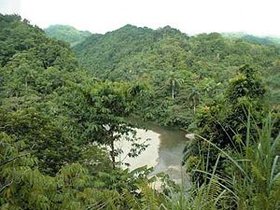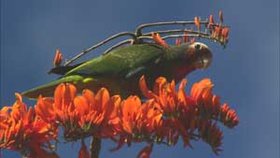Alejandro de Humbodlt National Park, Cuba
| Topics: |
Contents
- 1 Introduction
- 2 Geographical Location
- 3 Date and History of Establishment
- 4 Area
- 5 Land Tenure
- 6 Altitude
- 7 Physical Features
- 8 Climate
- 9 Vegetation
- 10 Fauna
- 11 Cultural Heritage
- 12 Local Human Population
- 13 Visitors and Visitor Facilities
- 14 Scientific Research and Facilities
- 15 Conservation Value
- 16 Conservation Management
- 17 IUCN Management Category
- 18 Further Reading
Introduction
Alejandro de Humboldt National Park is a World Heritage Site located in Cuba (Alejandro de Humbodlt National Park, Cuba) between 20°22'-20°35'N and 74°38'-75°10'W.
Geographical Location
The nominated World Heritage is located in the north-eastern part of Cuba in the provinces of Guantanamo and Holguin, covering most of the central part of the Saqua-Baracpa Mountain Range. The area lies between 20°22'-20°35'N and 74°38'-75°10'W
Date and History of Establishment
In 1963 the Jaguani and Cupeyal del Norte Natural Reserves were declared and in 1991 the Ojito de Agua Fauna refuge was established, all of which form part of the area of the nominated site. These three area were unified in 1996 as the Alejandro de Humboldt National Park (AHNP) and legally declared as such in 2001. The whole territory of the AHNP is also included in the Cuchillas del Toa Biosphere Reserve, declared in 1987.
Area
The nominated World Heritage site comprises a total of 71,140 hectares (ha). 68,890 ha of terrestrial area and 2,250 ha of marine area. A buffer zone of 500 meters (m) width has been declared from the boundaries of the Park.
Land Tenure
State-owned.
Altitude
From -220 m to 1,175 m (El Toldo Peak).
Physical Features

The nominated World Heritage site includes a complex system of mountains, tablelands, coastal plains, bays and coral reefs. In particular, coastal plains represent the highest and elongated system of plateaus and watersheds in the Caribbean region, with large weathering crusts and karstic (or pseudo-karstic) geological formations. It is a representative example of the combination of neo-tectonic evolution under conditions of sea shelf formation on ancient structures resulting from island arcs (Oligocene-Quaternary) with a foundation of transformed oceanic crusts (ophites). The site includes the limestone block of Farallones de Moa, a geological and biogeographic "island" composed of basic and ultra-basic serpentine rocks. This contains the karstic system of Farallones de Moa Great Cavern. Several rivers flow from the Park, including the Toa-Jaguani, Duaba, Jiguani, Nibujon, and Moa.
Climate
Hot, sub-tropical climate all year. Most rain falls between May and October and hurricanes can occur in autumn (August to November). Humidity varies between 75% and 95%. Cooler months are January to April when the least rain falls. Maximum temperature 32°C, minimum 15°C.
Vegetation
The nominated World Heritage site has the highest plant diversity of the Cuban archipelago and the Insular Caribbean. The site is also considered as the least explored natural area in Cuba and there still are locations from where a collection has never been made.
The terrestrial vegetation contains 16 of the 28 plant formations for Cuba, including low-altitude, submontane and montane rainforest, cloud forest, xeromorphic sub-thorny shrub, pine forests, semi-deciduous forest, riverine forest, and mangrove forest.
The Park has an incomplete flora list of 1,302 spermatophytes and 145 species of pteridophytes, of which 905 species are endemic to Cuba, representing almost 30% of all endemics reported for Cuba. Of this total figure, 343 species live exclusively in this area. The local flora includes five species of carnivore plants, one of which is Pinguicola lignicola, the only Cuban epiphyte. There are also two endemic species of the genera Podocarpus and Dracaena. According to recent collections, five new species to science have been made in the region, one of which is a pine. A species of the genus Buxus (reported as extinct) was found in the area too.
Fauna

The nominated World Heritage site holds the richest fauna in Cuba, with 10 species of mammals, 95 birds, 45 reptiles, 21 amphibians and 191 insects. At least 30% of the mammals, 21% of the birds, 83.3% of the reptiles, 95.8% of the amphibians and 27.7% of the insects are local or national endemisms. The area is of particular importance for several species are of particular conservation concern, notably ivory-billed woodpecker Campephilus principalis baird (CR - D), that is thought to be extinct, Cuban kite Chondrohierax wilsoni (CR - C2b), an endemic species whose populations has been so reduced that maybe just a few couples remain, and the Cuban solenodon Solenodon cubanus (EN - A1cde).
Forests in the region are important as refuge for many resident and migratory bird species, such as Cuban amazon Amazona leucocephala (NT) and Cuban parakeet Aratinga euops (VU). With regards to reptiles, three new species of Anolis lizards have been recently collected from the park. The frog Eleutherodactilus iberia, considered the smallest frog in the world, is restricted to only some locations in the Park. In the marine part of the park, there is a numerous colony of Caribbean manatee Trichechus manatus (VU).
Cultural Heritage
The territory where the nominated site is located has historically been poorly used by humans. Only one pre-Columbian archaeological site (Aguas Verdes) is known from the park. During the XVIII and XIX Centuries, some peripheral places were used as shelter sites ("palenques") by runaway slaves.
Local Human Population
At the beginning and middle of the XX Century, the valleys in the coast were occupied in order to raise coconut and cacao. During this period, some development activities associated with underground mining for minerals were carried out in the zone of La Melba. During the 40's and 50's, there was some farming activities along the Toa and Jaguaní riverbanks. These farms were left at the end of the 50's due to difficulties to get access and the poor quality of crops. In the 60's and 70's, there was some timber exploitation, particularly of pine, in the area of Ojito de Agua; such exploitation stopped definitively in the mid-80's, as a result of the declaration of the area as a Fauna Refuge. Within the Park the largest human settlement is La Melba, with about 400 inhabitants. The population of the buffer zone is estimated to be 4,000 people.
Visitors and Visitor Facilities
Almost all visitors to the Park are local people or researchers, although national and international ecotourism is being promoted by the government. Two small visitor centers, accommodation facilities and camping sites, a self-guided interpretative trail and other trails and guides have been prepared.
Scientific Research and Facilities
Scientific research expeditions of the fauna and flora have been conducted, but no further details are available.
Conservation Value
The conservation value of the nominated site is very high. AHNP is one of the most extensive and well-preserved mountain ecosystems in Cuba and the West Indies. It contains many endemic and endangered species (IUCN Red List Criteria for Endangered). These include the last remaining population of the Cuban kite Chondrohierax wilsoni (CR - C2b) and an important population of the Cuban solenodon Solenodon cubanus (EN - A1cde). The ivory-billed woodpecker Campephilus principalis baird (CR - D) was recorded in 1986, but may now be extinct. Three new species of Anolis lizards have been recently collected from the park. The frog Eleutherodactilus iberia, considered the smallest frog in the world, is restricted to only some locations in the Park. In the marine part of the park, there is a numerous colony of Caribbean manatee Trichechus manatus (VU). The levels of endemism recorded in the flora are amongst the highest of any area in the world.
Conservation Management
The conservation management of AHNP is the responsibility of the Ministry of Science, Technology and Environment (CITMA). A short-term operational plan was in operation in 1999. A management plan is under development. The park is included in a GEF-UNDP project to strengthen the National Protected Areas System of Cuba and also receives support from WWF-Canada.
Management Constraints
Historically mining has been one the largest threats to AHNP. The only existing mine is a subterranean one at La Melba. Commercial timber extraction in the pine woods in the area of Ojito de Agua during the 1960's and 1970's was stopped definitely in 19896 with the declaration of the area as a Faunal Refuge. The areas most affected by human activities are in the coastal valley of Santa Maria and Nibujon rivers and the vicinity of La Melba town, including agriculture. Hurricanes are a significant natural threat to the region.
Staff
In 1999 the staff of AHNP consisted of 12 professionals, 24 technicians, 18 workers, and 6 service workers.
Budget
In 1999 AHNP had national financing amounting to 300,000 Cuban pesos a year. The park is included in a GEF-UNDP project to strengthen the National Protected Areas System of Cuba and also receives support from WWF-Canada.
IUCN Management Category
- Alejandro de Humboldt National Park II (National Park)
- Natural World Heritage Site - Criteria ii, iv
Further Reading
- Agassiz, A. (1983). A reconnaissance of the Bahamas and elevated reefs of Cuba. Bulletin of the Museum of Comparative Zoology 26:1-203.
- Busto, R. del (1975). Las terrazas marinas de Maisí. Revista Ciencias 10, Universidad de la Habana. 10pp.
- Centro Nacional de Biodiversidad (1995). Estudio Nacional sobre la Diversidad Biológica en la República de Cuba. Agencia de Medio Ambiente, Ministerio de Ciencia, Tecnología y Medio Ambiente. Unpublished.
- Hernández, J.R., González, A. and Pérez, F. (1989). Deformaciones tectónicas de las terrazas marinas de la Sierra Maestra. Revista Ciencias de la Tierra y el Espacio: 115-131.
- IUCN (1996). 1996 IUCN Red List of Threatened Animals. IUCN, Gland, Switzerland. 368 pp. + annexes. ISBN: 2831703352.
| Disclaimer: This article is taken wholly from, or contains information that was originally published by, the United Nations Environment Programme-World Conservation Monitoring Centre (UNEP-WCMC). Topic editors and authors for the Encyclopedia of Earth may have edited its content or added new information. The use of information from the United Nations Environment Programme-World Conservation Monitoring Centre (UNEP-WCMC) should not be construed as support for or endorsement by that organization for any new information added by EoE personnel, or for any editing of the original content. |
</div>